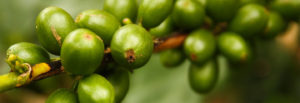Brief History of Coffee
The history of coffee is as rich as the brew itself! The first coffee plants are said to have come from the Horn of Africa on the shores of the Red Sea. Originally, coffee beans were taken as a food and not as a beverage. East African tribes would grind the coffee cherries together, mixing the results into a paste with animal fat. Rolled into little balls, the mixture was said to give warriors much-needed energy for battle. Later, around the year 1000 AD, Ethiopians concocted a type of wine from coffee berries, fermenting the dried beans in water. Coffee also grew naturally on the Arabian Peninsula, and it was there, during the 11th century that coffee was first developed into a hot drink.

THE LEGEND OF THE BEAN
The so-called stimulating properties of coffee were thought by many during these ancient times to give a sort of religious ecstasy, and the drink earned a very mystical sort of reputation, shrouded in secrecy and associated with priests and doctors. So, it is not surprising that two prominent legends emerged to explain the discovery of this magic bean.
According to one story, a goat-herder noticed that his herd became friskier than usual after consuming the red cherries of a wild coffee shrub. Curious, he tasted the fruit himself. He was delighted by its invigorating effects, and was even spotted by a group of nearby monks dancing with his goats. Soon the monks began to boil the bean themselves and use the liquid to stay awake during all-night ceremonies.
COFFEE AROUND THE WORLD
The cultivation of coffee began sometime in the fifteenth century, and for many centuries to follow, the Yemen province of Arabia was the world’s primary source of coffee. The demand for coffee in the Near East was very high. The beans leaving the Yemeni port of Mocha for trade with Alexandria and Constantinople were highly guarded. In fact, no fertile plants were allowed to leave the country. Despite the restrictions, Muslim pilgrims from across the globe during their pilgrimages to Mecca managed to smuggle coffee plants back to their homelands, and coffee crops soon took root in India.
Coffee also made its way into Europe around this time through the city of Venice, where fleets traded perfumes, teas, dyes and fabrics with Arabic merchants along the Spice Route. The beverage eventually gained popularity with the masses when street lemonade vendors began selling it in addition to cold beverages. Many European merchants grew accustomed to drinking coffee overseas and brought it back with them.
By the middle of the 17th century the Dutch dominated the world’s merchant shipping industry, and they introduced large-scale coffee cultivation to their colonies in Indonesia on the islands of Java, Sumatra, Sulawesi and Bali.
Coffee arrived in Latin America several decades later, when the French brought a cutting of a coffee plant to Martinique. But when a rare plant disease spread through the coffee fields of Southeast Asia in the mid-19th century, Brazil emerged as the world’s foremost coffee producer, an honor the country still holds today.